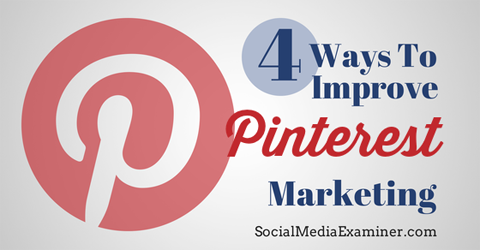 Do you use Pinterest to market your business?
Do you use Pinterest to market your business?
Do you use Pinterest analytics to help you market better?
Most brands on Pinterest aren't tracking their metrics. The companies that do are finding optimized engagement.
In this article I'll share four ways to improve your Pinterest marketing efforts.
Note: There are a number of third-party apps that track Pinterest analytics for you. This article focuses on how those metrics can help you market more successfully, not on the tools themselves.

#1: Invest Resources in the Right Boards
Pinterest is built on the Interest Graph, not the Social Graph. In other words, Pinterest aims to connect you with people who share your passions, not necessarily the people you know (as most other networks do).
Each Pinterest board you create is a way to organize your pins by topic so others who are interested in the same topic can engage with your pins. You may or may not know those users, but you connect because you share images and products they appreciate (via pins and repins).
Pins, repins, likes and comments reflect that connection. To keep that engagement coming, compare your boards' stats side by side to see which topics are most interesting to your target Pinterest audience.

Look at virality (the average number of repins per original pin) in particular. Higher virality scores are a good thing—they mean your content is reaching interested users who repin it to their own boards.
Keep adding to the boards that are performing successfully, and make new boards based on similar topics.
Tip: If one of your boards isn't panning out, don't delete it. Even though that board isn't part of your main focus anymore, users may have liked or repinned items from the board or may have linked to it from their blog. If you delete the board, those links are broken.
#2: Publish During Prime Pinning Times
As a company, when you pin is important. Timing is everything. Like your other social profiles, scheduling updates (or pins in this case) helps you reach the right audience at the right time.
So how do you know the best times to pin? The simplest way to find out is to use a pin-scheduling tool that tracks and recommends optimal sharing times. Alternately, you could mine data yourself and find your own sweet spots through trial and error.
Get World-Class Marketing Training — All Year Long!
Are you facing doubt, uncertainty, or overwhelm? The Social Media Marketing Society can help.
Each month, you’ll receive training from trusted marketing experts, covering everything from AI to organic social marketing. When you join, you’ll also get immediate access to:
- A library of 100+ marketing trainings
- A community of like-minded marketers
- Monthly online community meetups
- Relevant news and trends updates
When you schedule your pins to post during prime pinning times, you'll see an initial bump in repins. When you pin something, many of your followers repin it, and many of their followers repin it as well.

That initial bump means more impressions, more traffic and perhaps more revenue. The resulting wider reach may lead to additional downstream exposure in category feeds, search results and new Interest pages.

Discover Proven Marketing Strategies and Tips
Want to go even deeper with your marketing? Check out the Social Media Marketing Podcast! Publishing weekly since 2012, the Social Media Marketing Podcast helps you navigate the constantly changing marketing jungle, with expert interviews from marketing pros.
But don’t let the name fool you. This show is about a lot more than just social media marketing. With over 600 episodes and millions of downloads each year, this show has been a trusted source for marketers for well over a decade.
Scheduling also helps you avoid bombarding your audience with too many pins at once.
If you're a general Pinterest user (not posting as a company), you've experienced that moment when you realize you've just been pinning for three hours and forgot to eat dinner. And all of those pins you were sharing? They've taken over your followers' stream.
That's bad enough for a general user, but if a business over-pins, that can be a real problem—users unfollow you if you're in their stream too often. Flooding followers' feeds in a short period of time makes it feel like you're being too salesy, even if you don't pin again for the next three days. Scheduling pins lets you spread out pinning sprees for your followers' sake.
Tip: Even if your market is local, find out who else loves your product and is sharing it—they may be halfway around the world! Scheduling pins lets you share your products in the time zones that match your overall audience, not just your immediate audience.
#3: Identify Influential Pinners and Advocates
Most brands on Pinterest don't have a very large following, and that's OK—we all start out at zero, right? It takes consistent effort over time to build a valuable earned media channel on Pinterest. And you're going to need help along the way.
Paying attention to your Pinterest analytics helps you find two critical types of users who contribute to your Pinterest growth: influential pinners and brand advocates.

Influential pinners reliably generate a fantastic number of impressions and repins. By analyzing which of your followers already has substantial reach, you can find potential allies in your quest to grow on Pinterest. Invest in these relationships for the long-term.
Users who are already pinning directly from your website or repinning your pins are sending you a signal that they love your content, products or brand. Lean into that. These brand advocates help you grow your presence.
#4: Get Instant Product Feedback
Pinterest data takes the guesswork out of stocking the shelves or choosing which product or service to develop next. It's like having an enormous online focus group without spending tens of thousands of dollars.
By posting images of potential new products on Pinterest, you can observe which products take off and which ones don't. Analyze that data by geographic area, and then use that information to better predict which items will sell (and where) before you place an order.

Such predictive merchandising could become a sustainable competitive advantage in industries such as retail, ecommerce, automotive sales and more.
Wrapping Up
Analytics can be a double-edged sword for marketers. We know we should guide our tactics with data, but gathering the necessary metrics and figuring out how to apply insights is time-consuming, so we often stop at simple reporting.
Pinterest offers a wealth of marketing feedback. It's worth setting aside some time to delve into the analytics to see what is or isn't working. You'll likely find trends you can use as an advantage over competitors.
What do you think? Do you use Pinterest analytics to improve your marketing? Which metrics have you found to be most helpful? Please leave your comments below.
Attention Agency Owners, Brand Marketers, and Consultants

Introducing the Marketing Agency Show–our newest podcast designed to explore the struggles of agency marketers.
Join show host and agency owner, Brooke Sellas, as she interviews agency marketers and digs deep into their biggest challenges. Explore topics like navigating rough economic times, leveraging AI, service diversification, client acquisition, and much more.
Just pull up your favorite podcast app, search for Marketing Agency Show and start listening. Or click the button below for more information.

